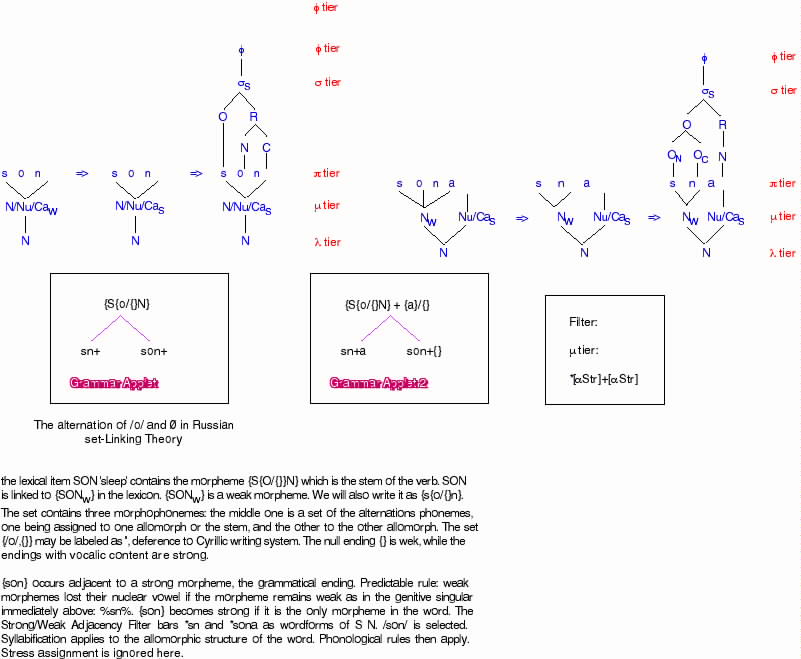

![]()
There must be a representation for the morpheme that contains the allomorphs /son/ and /sn-/ in Russian. The problem is how to represent it. We can't represent it as SON, since 'O' has two allophones: [o] and schwa. And "SN" won't work either since when /o/ is inserted is unpredictable. Labelling is arbitrary at the best of times, though it is common to label words based on either their spelling or their phonemic form. Neither of these will do as is.
We adopt set theory and a weak form of Optimality Theory. We view /son/ and /sn/ as allomorphs, which belong to the set {son, sn}. A filter blocks /sn/ occurring as a word:
*##Cn##.
The filter blocks any word from having no vowel. Russian does not have syllabic laterals in the stressed position. Hence, of the set, /son/ must pass through in the masculine singular nomintive: son "dream".
Another filter is needed to block 'son' in the remaining cases, except for the genitive plural. To do this we consider the allomorph 'sn' to be unmarked, and 'son' marked. :
*##son+[+Seg]##
The marked version cannot occur with an ending that has phonological form, makred by the feature [+Seg(ment)].
Reformatting the above into sets, we can gain further insight on the problem. In set theory, a set can be emtpy, contain one member, or two or more members. A set can be made out of any two or more members. However, we want to look at sets of a certain types—if two phonemes are in a morphophonemic alternation, they contain a set. The set of the alternation of /o/ and zero, preferably viewed as the emtpy set ‘{}'. This set needs a label for convience. We cannot label it "o" or "º". We need "o" for the set, enclosed in braces, {ó, V , ´}. If 'º' is to b e used, it must be used for the empty set; but I prefer ‘{}' for the emtpy set. I propose that we label this alternating set as '!'. Note that '!' is not an underlying form, but merely the label for the set. The Russian noun 'son' "son" is represented as {S !N} which is equivalent to {S{o, º}N}.
In set theory terms, we propose the following correspondence rules, which we prefer to view as correspondences. Correspondences are competence rules which map the morphophonemic set to a phonemic set and interpret a phonological string. First the mapping rules:
! &Mac251; /o/ / Cn + [-Seg]
! &Mac251; {} (default).
Or we can state the correspondences in terms of a filter:
*! &Mac251; {} / Cn + [-Seg]
*! &Mac251; /o/ / Cn + [+Seg].
The filter blocks the null variant if there is no phonological ending and it block the /o/ variant if there is a phonological ending. The first of this pair filters out vowelless stems if there is no ending. The second is not so natural. Ideally it would be better to have a rule that would select 'o' in a different way.
There is another way. Suppose we consider the two members of the set are [+Str] = /o/, and [-Str] = {}. The feature [±STR] is relative to two members of a set such that {} is always [-Str]. The same feature interacts with the same feature in an adjacent syllable. By this criteria th null inflectional ending [-Pl, +Nom, 1st Declension] {} is [-Str], and the vocalic endings are [+Strong] as opposed to the null ending.
The filter blocks a sequence of two similarly marked morphemes. Nonalternating vowels do not display the feature [±Strong], and consequently are not affected by the filter. '±Strong' is a property of morphology, not phonology:
*[aStr]+[aStr], at the m-tier.
For this to work efficiently, we should refer to a morphological layer. Then the filter blocks two weak morphemes or two strong morphemes from occurring in sequence in a word. As far as I know, the morphophoneme '!' occurs only before inflectional endings.
The alternating set {e, {}} is like the {o, {}}. Its member /e/ is strong. {} is always weak. This occurs in the alternation "den'" and "dnja" -- 'day.'
![]()